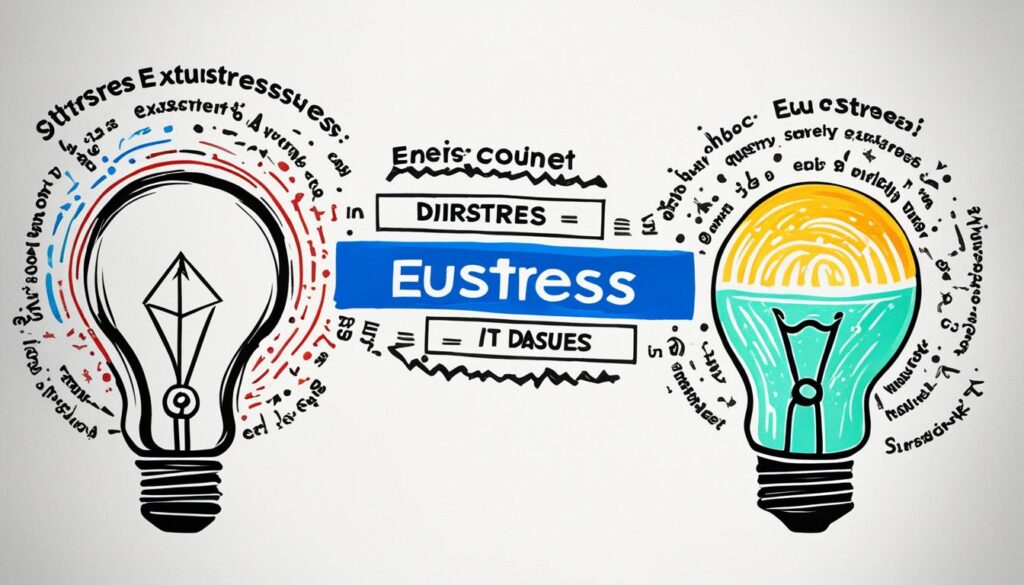Did you know that stress can have both positive and negative effects on our well-being? Stress is not always a bad thing. A certain amount of stress can be beneficial for our motivation and performance. This is where the concepts of eustress and distress come into play. Let’s explore the compare and contrast eustress with distress.
Eustress and distress are two sides of the same coin, representing different experiences of stress. While eustress refers to positive stress that energizes and motivates us, distress is the negative stress that overwhelms and debilitates us. Understanding the differences between these two types of stress is crucial for managing our overall well-being.
Key Takeaways
- Eustress and distress are two different experiences of stress.
- Eustress is positive stress that energizes and motivates us.
- Distress is negative stress that overwhelms and debilitates us.
- Understanding the differences between eustress and distress is important for managing our well-being.
- Both eustress and distress can have significant effects on our mental health.
Understanding Stress and Its Impact on Our Lives
In this section, we will explore the concept of stress and its profound impact on our lives. Stress is a physiological and psychological response to external and internal demands, affecting individuals both physically and emotionally. It is a natural reaction that can be triggered by various factors such as work, relationships, financial challenges, and health concerns. Understanding stress is essential for managing its effects and maintaining overall well-being.
The Definition of Stress and Its Universal Presence
Stress is a universal phenomenon that affects individuals across all cultures and walks of life. It can be defined as the body’s response to any demand or pressure, whether positive or negative, that requires adaptation. It can manifest as emotional, physical, or cognitive strain, impacting multiple aspects of our lives.
Stress can arise from both external factors, such as work deadlines or relationship conflicts, and internal factors, such as self-imposed expectations or perfectionism. It can vary in intensity, duration, and individual response. Regardless of the specific triggers, stress is an inherent part of human existence and can shape our experiences and behaviours.
Stress as a Catalyst for Mental Health Disorders
While stress is a natural part of life, prolonged or excessive exposure to stressors can have detrimental effects on our mental health. Stress can act as a catalyst for the development or exacerbation of mental health disorders, such as anxiety disorders, depressive disorders, and post-traumatic stress disorder (PTSD).
The impact of stress on mental health can be significant, leading to emotional distress, impaired cognition, and disrupted behaviour patterns. Chronic stress can contribute to the onset of mental health disorders by disrupting the brain’s neurochemical balance and impairing the body’s stress response system.
It is crucial to recognize the connection between stress and mental health disorders to ensure appropriate support and intervention for individuals experiencing excessive stress. By understanding the relationship between stress and mental health, we can work towards creating strategies and resources to mitigate the negative impact of stress and foster mental well-being.
Impact of Stress on Mental Health Disorders
| Mental Health Disorder | Impact of Stress |
|---|---|
| Anxiety Disorders | Elevated levels of stress can trigger or worsen symptoms of anxiety disorders, leading to increased nervousness, panic attacks, and avoidance behaviour. |
| Depressive Disorders | Chronic stress can contribute to the development or aggravation of depressive symptoms, including low mood, loss of interest, and feelings of hopelessness. |
| Post-Traumatic Stress Disorder (PTSD) | Stressful or traumatic events can trigger the onset of PTSD, a condition characterized by intrusive memories, hypervigilance, and emotional reactivity. |
Defining Eustress: The Positive Side of Stress
In this section, we will focus on eustress, which is the positive side of stress. Eustress can be defined as a type of stress that motivates and energizes individuals positively. It is important to note that eustress differs from distress, which is negative stress that overwhelms and debilitates individuals.
Eustress is often associated with feelings of excitement, motivation, and fulfilment. It occurs in situations where individuals feel challenged and stimulated, pushing them to achieve their goals and perform at their best. Unlike distress, eustress is not harmful to our overall well-being.

There are several benefits and positive effects of eustress on our well-being. It can boost our productivity, enhance our ability to cope with challenges and improve our overall mental health.
Eustress can provide a sense of meaning and purpose in our lives, as well as increase our self-esteem and confidence. When we experience eustress, we often feel a sense of fulfilment and satisfaction, which contributes to our overall happiness and well-being.
Understanding the positive aspects of eustress and how it differs from distress is crucial in managing stress effectively. By embracing eustress and harnessing its benefits, we can cultivate a healthy relationship with stress and use it to our advantage.
Characterizing Distress: When Stress Becomes Overwhelming
In this section, we will delve into the characteristics of distress, focusing on what happens when stress becomes overwhelming. Distress is a state of extreme psychological or emotional strain that can have significant impacts on mental well-being. When stress reaches a point where it exceeds an individual’s ability to cope, it becomes distressing and can lead to a variety of negative effects.
Distress in the Wake of COVID-19
The COVID-19 pandemic has brought unprecedented levels of distress to individuals around the world. The uncertainty, fear, and disruption caused by the spread of the virus have created a fertile ground for overwhelming stress.
The pandemic has resulted in job losses, financial difficulties, social isolation, and the loss of loved ones, all of which contribute to a heightened sense of distress and its long-lasting impact on mental health.

Long Term Effects of Distress on Mental Health
The long-term effects of distress on mental health cannot be underestimated. Prolonged exposure to distress can lead to the development or exacerbation of mental health disorders such as anxiety and depression. It can also contribute to physical health problems, sleep disturbances, and impaired social functioning.
The consequences of distress can be far-reaching and can significantly impact an individual’s overall well-being and quality of life.
Understanding and addressing distress is essential for maintaining good mental health. By recognizing the signs of overwhelming stress and seeking appropriate support and resources, individuals can take steps towards managing and mitigating the negative effects of distress.
Compare and Contrast Eustress with Distress: Core Differences
In this section, we will compare and contrast eustress with distress and highlight their core differences. Understanding the distinctions between these two types of stress is crucial for managing our well-being effectively.
Eustress refers to positive stress that motivates and energizes individuals. It is characterized by feelings of excitement and a sense of fulfilment. Eustress can be experienced when pursuing personal goals, engaging in challenging activities, or experiencing positive life events such as starting a new job or getting married.
On the other hand, distress is negative stress that overwhelms and debilitates individuals. It is often associated with feelings of anxiety, worry, and a sense of being overwhelmed by life’s challenges. Distress can arise from various sources, including work-related pressures, relationship problems, or traumatic events.
One of the core differences between eustress and distress lies in their impact on individuals. While eustress can have a positive effect on our well-being, motivating us to achieve goals and overcome challenges, distress can have detrimental effects on our mental and physical health. Distress can lead to symptoms of anxiety, depression, and other mental health disorders.
Another difference is the intensity of eustress and distress. Eustress is typically moderate in intensity, providing an optimal level of arousal that helps individuals perform at their best. It stimulates creativity and problem-solving abilities. In contrast, distress is often high in intensity and can become overwhelming, impairing individuals’ ability to function effectively.
Furthermore, eustress and distress have different outcomes. Eustress is associated with positive outcomes, such as personal growth, increased resilience, and improved overall well-being. It can enhance productivity and increase satisfaction in various areas of life. In contrast, distress can lead to negative outcomes, including burnout, decreased performance, and a decline in mental and physical health.
To summarize, eustress and distress differ in terms of their impact, intensity, and outcome. Eustress has a positive impact, moderate intensity, and leads to positive outcomes, while distress has a negative impact, high intensity, and leads to negative outcomes. By understanding these core differences, individuals can better identify and manage the types of stress they experience in their lives.

Psychological Effects of Eustress vs. Distress on Individuals
Enhancing Productivity Through Eustress
Eustress, the positive side of stress, can have profound psychological effects on individuals. When experiencing eustress, individuals are motivated, focused, and energized, leading to enhanced productivity and performance. This type of stress triggers a sense of excitement and fulfilment, promoting a positive mindset and a greater sense of well-being. By harnessing the psychological effects of eustress, individuals can find themselves more engaged, creative, and efficient in their work.
One of the key benefits of eustress is its ability to activate the body’s stress response healthily. This response releases hormones like adrenaline and cortisol, which can boost cognitive function, memory, and concentration. Eustress creates a flow state, where individuals feel fully absorbed in their tasks and experience a sense of accomplishment.
This heightened state of focus and engagement can significantly contribute to increased productivity and success in various aspects of life.

The Spiral of Distress Leading to Burnout
On the other hand, distress, the negative side of stress, can have detrimental psychological effects on individuals. When distress becomes overwhelming, it can lead to a downward spiral of emotional and physical exhaustion, often resulting in burnout. Distress can manifest as feelings of anxiety, depression, and helplessness, significantly impacting an individual’s mental well-being.
The psychological effects of distress can include a decrease in motivation, concentration, and overall cognitive functioning. Individuals experiencing distress may find it challenging to manage their emotions, leading to negative thoughts and behaviours. Distress can also disrupt sleep patterns, appetite, and overall lifestyle, further contributing to a decline in mental health.
The spiral of distress leading to burnout is a cycle where individuals become trapped in a state of chronic stress and exhaustion. This cycle can have severe consequences on both professional and personal aspects of life, impacting relationships, job performance, and overall quality of life.
Recognizing the psychological effects of distress is crucial in preventing burnout and promoting well-being. Taking proactive measures to reduce distress and cultivating healthy coping mechanisms can help individuals regain control and restore balance in their lives.
Psychological Effects of Eustress vs. Distress on Individuals
Enhancing Productivity Through Eustress
Eustress, the positive side of stress, can have profound psychological effects on individuals. When experiencing eustress, individuals are motivated, focused, and energized, leading to enhanced productivity and performance.
This type of stress triggers a sense of excitement and fulfilment, promoting a positive mindset and a greater sense of well-being. By harnessing the psychological effects of eustress, individuals can find themselves more engaged, creative, and efficient in their work.
The Spiral of Distress Leading to Burnout
On the other hand, distress, the negative side of stress, can have detrimental psychological effects on individuals. When distress becomes overwhelming, it can lead to a downward spiral of emotional and physical exhaustion, often resulting in burnout. Distress can manifest as feelings of anxiety, depression, and helplessness, significantly impacting an individual’s mental well-being.
The psychological effects of distress can include a decrease in motivation, concentration, and overall cognitive functioning. Individuals experiencing distress may find it challenging to manage their emotions, leading to negative thoughts and behaviours. Distress can also disrupt sleep patterns, appetite, and overall lifestyle, further contributing to a decline in mental health.
The Role of Gender in Eustress and Distress Responses
In the previous sections, we explored the concepts of eustress and distress, their impact on our lives, and the psychological effects they can have on individuals. Now, we turn our attention to the role of gender in eustress and distress responses. Gender plays a significant role in how individuals perceive, experience, and cope with stress.
Gender-Specific Coping Mechanisms
Men and women often employ different coping mechanisms when faced with stress. These gender-specific coping mechanisms arise from socialization, cultural expectations, and biological differences. Research has shown that men tend to use problem-focused coping strategies, which involve actively addressing and solving the stressor. On the other hand, women often employ emotion-focused coping strategies, focusing on managing the emotional impact of the stressor.
While both approaches can be effective, it’s crucial to recognize that individuals may adapt their coping strategies based on their unique circumstances and personal preferences.
Moreover, gender-specific coping mechanisms can influence not only how individuals respond to stress but also the outcomes they achieve. For example, women’s emotion-focused coping strategies may contribute to their greater likelihood of seeking social support during stressful situations. This can create stronger social connections and foster a sense of community, which can provide additional emotional support and buffer against distress.
Research Insights on Gender Disparities in Stress Perception
Studies have highlighted gender disparities in stress perception, indicating that men and women may experience stress differently. Research suggests that women may exhibit higher levels of stress reactivity and sensitivity to stressors due to hormonal and physiological differences. Furthermore, societal expectations and gender norms can shape how stress is perceived and expressed, potentially leading to disparities in stress-related outcomes.
A study conducted by Smith et al. (2020) examined the gender differences in stress response among a sample of working adults. The findings revealed that women reported higher levels of stress across various domains, including work-related stress and caregiving responsibilities. These gender disparities in stress perception can have implications for mental health and well-being, underscoring the importance of addressing gender-specific stressors and providing appropriate support.
Managing Emotional Stress: Strategies for Maintaining Balance
In today’s fast-paced and demanding world, managing emotional stress is essential for maintaining overall well-being. The pressures of work, relationships, and everyday life can take a toll on our mental and emotional health. However, by incorporating effective strategies into our lives, we can develop resilience and maintain a healthy balance. Here are some strategies that can help us manage emotional stress:
- Self-Care: Taking care of ourselves is crucial for managing emotional stress. Engaging in activities that bring us joy and relaxation, such as exercise, meditation, or hobbies, can help reduce stress levels and promote emotional well-being.
- Time Management: Proper time management can alleviate stress caused by overwhelming tasks and deadlines. Creating a schedule, setting priorities, and breaking tasks into manageable chunks can help us stay organized and reduce stress.
- Healthy Relationships: Nurturing and maintaining healthy relationships can provide emotional support during challenging times. Connecting with loved ones, seeking support from friends or family, and cultivating positive social interactions can help us cope with emotional stress.
- Stress-Relief Techniques: Incorporating stress-relief techniques into our daily routine can significantly reduce emotional stress. Deep breathing exercises, practising mindfulness, or engaging in relaxation techniques, such as yoga or tai chi, can help calm the mind and relax the body.
- Seeking Professional Help: If emotional stress becomes overwhelming and affects our daily functioning, seeking professional help from a therapist or counsellor can provide valuable guidance and support. Therapy sessions can help us develop coping mechanisms and strategies specific to our individual needs.
By implementing these strategies, we can effectively manage emotional stress and maintain a healthy balance in our lives. Remember, managing emotional stress is an ongoing process, and it’s important to prioritize self-care and prioritize our mental and emotional well-being.

Real-life Examples: Eustress vs. Distress in the Workplace
In this section, we will examine real-life examples of eustress and distress in the workplace. By understanding how these types of stress manifest in a work setting, we can gain insights into their impact on employee wellness and organizational productivity.
Navigating Work Challenges: Eustress as a Motivator
Eustress, the positive form of stress, can act as a motivator in the workplace. When employees experience eustress, they feel challenged, engaged, and energized by their work tasks.
This type of stress can foster creativity, innovation, and personal growth. For example, taking on a new project or pursuing a career advancement opportunity can generate eustress, encouraging individuals to push their boundaries and reach their full potential. Eustress helps individuals maintain high levels of motivation, leading to increased job satisfaction and productivity.
“Eustress is like the wind beneath our wings, propelling us to achieve greatness in the workplace.”
Work-Related Distress and Its Consequences on Employee Wellness
On the other hand, work-related distress poses significant challenges to employee wellness. When individuals face excessive work demands, job insecurity, or toxic work environments, distress can take hold. This negative form of stress often leads to feelings of overwhelm, anxiety, and burnout.
Work-related distress can have severe consequences on both the mental and physical well-being of employees. It can result in decreased job satisfaction, decreased productivity, and increased rates of absenteeism. Over time, unmitigated distress can contribute to the development of mental health disorders such as depression, anxiety, and even cardiovascular diseases.
Organizations must identify and address sources of work-related distress to protect employee wellness and foster a positive work environment. Implementing strategies such as work-life balance initiatives, stress management programs, and creating open lines of communication can help mitigate distress and promote employee well-being.
A Comparison of Eustress and Distress in the Workplace
| Eustress | Distress | |
|---|---|---|
| Impact on Performance | Enhances performance and productivity | Decreases performance and productivity |
| Emotional Experience | Feelings of excitement and fulfilment | Feelings of overwhelm and anxiety |
| Long-term Effects | Positive personal growth and resilience | Burnout, mental health disorders |
| Work Environment | Positive and motivating | Toxic and draining |
The table above provides a visual representation of the key differences between eustress and distress in the workplace. It highlights the impact on performance, emotional experience, long-term effects, and work environment. Understanding these distinctions is essential for organizations and individuals to navigate work challenges effectively and support employee well-being.
The Impact of ManthanHub’s Brain Rewire on Different Stress Levels
Eustress:
Positive Impact: ManthanHub’s Brain Rewire fosters eustress, which is beneficial stress. It encourages growth, motivation, and resilience. Participants experience excitement, focus, and a sense of achievement. Eustress helps optimize performance and promotes well-being.
Stress:
Balancing Act: The program acknowledges that stress is a natural response to challenges. Brain Rewire equips individuals with coping mechanisms, mindfulness techniques, and emotional regulation tools. It helps manage stress effectively, preventing it from becoming overwhelming.
Distress:
Mitigation: For those experiencing distress—excessive, harmful stress—Brain Rewire provides a lifeline. It offers strategies to reduce anxiety, improve mental health, and restore balance. Participants learn to identify triggers and build resilience against distress.
In summary, ManthanHub’s Brain Rewire empowers individuals to navigate stress levels, fostering overall well-being.
Conclusion
In conclusion, this article has examined the concepts of eustress and distress, highlighting their similarities and differences. Eustress, the positive side of stress, motivates and energizes individuals, while distress overwhelms and debilitates them. Understanding the impact of both types of stress is crucial for our overall well-being.
Throughout the article, we explored the psychological effects of eustress and distress. Eustress can enhance productivity and fulfilment, while distress can lead to burnout and emotional exhaustion. Recognizing the signs and learning to manage these types of stress is essential in maintaining a healthy balance.
We also discussed how eustress and distress manifest in different contexts, such as the workplace. Eustress can serve as a motivator, enhancing employee performance and engagement. On the other hand, work-related distress can have negative consequences on employee wellness and organizational productivity.
In conclusion, by understanding and managing both eustress and distress, we can navigate the challenges of life more effectively. Recognizing the signs and implementing strategies for maintaining balance will contribute to our overall well-being and provide a solid foundation for a fulfilling life.
FAQ
What is the difference between eustress and distress?
Eustress refers to positive stress that motivates and energizes individuals, while distress refers to negative stress that overwhelms and debilitates individuals.
How do eustress and distress impact our lives?
Eustress can enhance productivity and improve overall well-being, while distress can lead to the spiral of burnout and have long-term effects on mental health.
What are some physical signs of stress?
Physical signs of stress can include changes in diet, sleep patterns, and routine. These are all physical manifestations of stress.
How can stress be a good thing?
Stress can be a good thing when it is eustress, as it can motivate and energize individuals, leading to increased productivity and fulfilment.
What is the General Adaptation Syndrome response?
The General Adaptation Syndrome response includes three stages: alarm, resistance, and exhaustion. This response is the body’s physiological reaction to stress.
How does distress differ from eustress in terms of impact?
Distress has a negative impact and can overwhelm individuals, while eustress has a positive impact and can motivate and energize individuals.
How does gender influence the response to eustress and distress?
Gender can influence coping mechanisms and the way individuals perceive and experience stress. There may be gender disparities in stress perception and response.
What are some strategies for managing emotional stress?
Strategies for managing emotional stress include practicing self-care, ManthanHub brain rewire, engaging in stress-reducing activities, seeking support from others, and practicing mindfulness and relaxation techniques.
How does work-related distress affect employee wellness?
Work-related distress can have negative consequences on employee wellness, leading to decreased productivity, burnout, and potential mental health issues.




